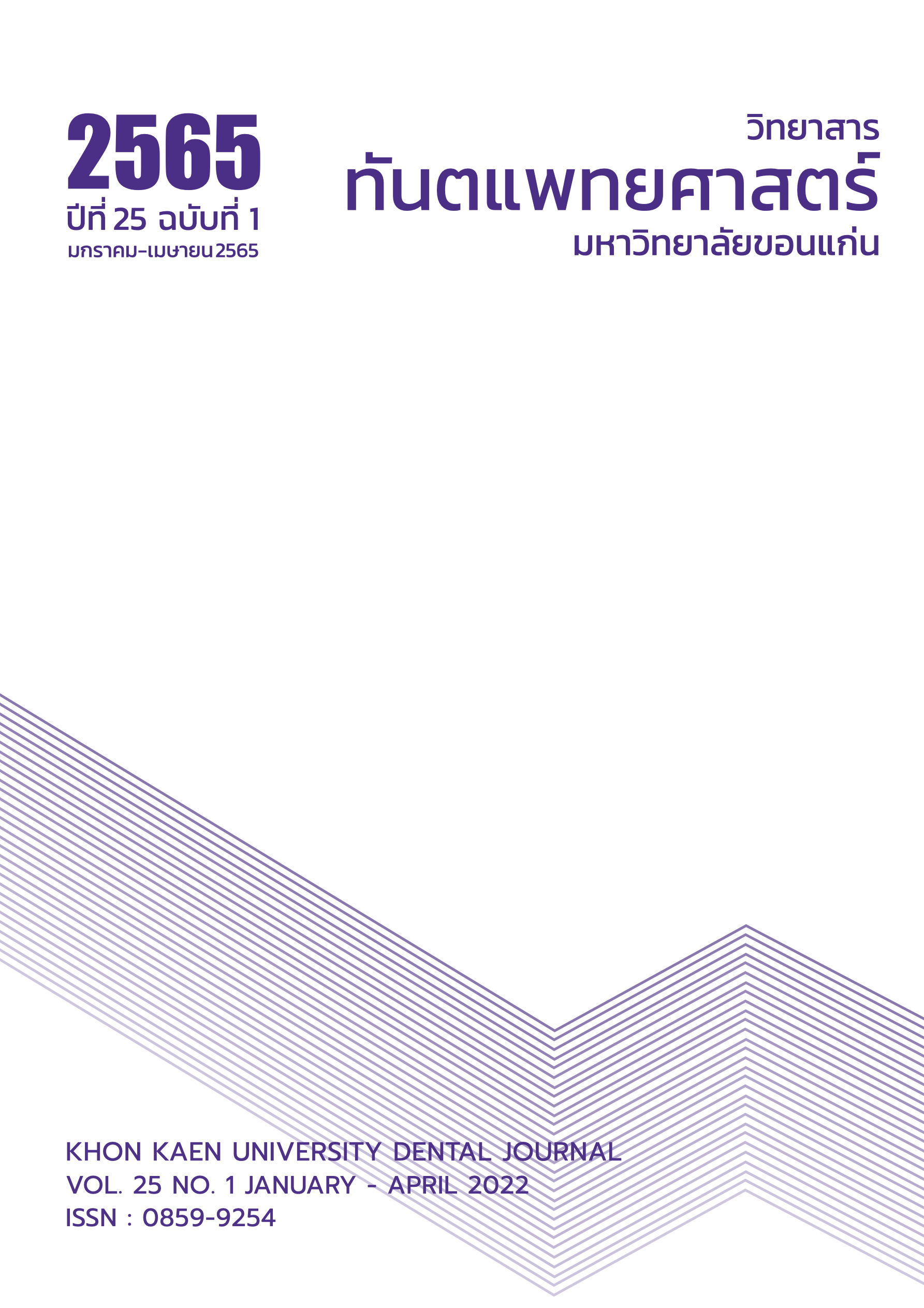Effect of Powder to Liquid Ratio on the Push Out Bond Strength of Biodentine TM
Main Article Content
Abstract
The objective of this study was to determine the effect of different powder-to-liquid ratio on the push out bond strength of BiodentineTM (BD). The methods used in this study were as follows: 32 single root permanent human teeth were open access with round diamond burs and prepared root canal with peeso reamer burs no.1-4, respectively. The size of the final diameter of the root canal is 1.4 mm. The prepared root canals were randomly filled with four types of material: MTA BD1:4 BD1:5 and BD1:6. The roots were cut into 3-mm thick sections and 16 samples of each group were randomized and then divided into two groups. The push-out test was performed with a Universal Testing Machine at 24 hours and 28 days after storage in PBS. The results were statistically analyzed using One-way ANOVA and Tukey's HSD test. The results of this study were as follows: at 24 hours, the highest push-out bond strength in BD1:6 that is 17.569 MPa with statistically significant differences. In contrast, at 28 days, the BD1:5 and BD1:4 groups showed a significantly higher push-out bond strength at 15.619 and 14.704 MPa than BD1:6 and MTA that are 10.169 and 10.725 MPa. In conclusion, a different powder-to-liquid ratio affected the push out bond strength of BiodentineTM, and BD1:5 and BD1:4 showed higher push-out bond strength than BD1:6 with a statistically significant difference.
Article Details

This work is licensed under a Creative Commons Attribution-NonCommercial-NoDerivatives 4.0 International License.
บทความ ข้อมูล เนื้อหา รูปภาพ ฯลฯ ที่ได้รับการลงตีพิมพ์ในวิทยาสารทันตแพทยศาสตร์ มหาวิทยาลัยขอนแก่นถือเป็นลิขสิทธิ์เฉพาะของคณะทันตแพทยศาสตร์ มหาวิทยาลัยขอนแก่น หากบุคคลหรือหน่วยงานใดต้องการนำทั้งหมดหรือส่วนหนึ่งส่วนใดไปเผยแพร่ต่อหรือเพื่อกระทำการใด ๆ จะต้องได้รับอนุญาตเป็นลายลักษณ์อักษร จากคณะทันตแพทยศาสตร์ มหาวิทยาลัยขอนแก่นก่อนเท่านั้น
References
Johnson BR, Fayad MI. Periradicular surgery. In: Hargreaves KM, Berman LH, Rotstein I, editors. Cohen's Pathways of the Pulp. 11th ed. California: Elsevier; 2011. 387-446.
Brichko J, Burrow MF, Parashos P. Design variability of the Push-out bond test in endodontic research: A systematic review. J Endod 2018;44(8):1237-45.
Torabinejad M, Chivian N. Clinical applications of mineral trioxide aggregate. J Endod 1999;25(3):197-205.
Sarkar N, Caicedo R, Ritwik P, Moiseyeva R, Kawashima I. Physicochemical basis of the biologic properties of mineral trioxide aggregate. J Endod 2005;31(2):97-100.
Islam I, Chng HK, Yap AUJ. Comparison of the physical and mechanical properties of MTA and Portland cement. J Endod 2006;32(3):193-7.
Zhou H, Shen Y, Wang Z, Hakkinen L, Haapasalo M.. In vitro cytotoxicity evaluation of a novel root repair material. J Endod 2013;39(4):478-83.
Mazumdar P, Das UK, Rahaman S, Das S. A comparative evaluation of the sealing ability of biosilicate material, mineral trioxide aggregate, light cure glass ionomer cement, silver amalgam as root end filling materials by dye penetration method. Int Med J 2013;20(2):232-4.
Rajasekharan S, Martens L, Cauwels R, Verbeeck R. Biodentine™ material characteristics and clinical applications: a review of the literature. Eur Archives Paediatr Dent 2014;15(3):147-58.
Alisanunt P. A comparative study on some physical properties of Biodentine in different water to powder ratios [dissertation]. Srinakarinwirot (SWU): Univ of Srinakarinwirot; 2014.
Warangkarat W. A comparative study on surface and compressive strength of Biodentine in different water to powder ratio [dissertation]. Srinakarinwirot (SWU): Univ of Srinakarinwirot; 2015.
Türker SA, Uzunoglu E. Effect of powder to water ratio on the push out bond strength of white mineral trioxide aggregate. Dent Traumatol 2016;32(2):153-5.
Guneser MB, Akbulut MB, Eldeniz AU. Effect of various endodontic irrigants on the push-out bond strength of biodentine and conventional root perforation repair materials. J Endod 2013;39(3):380-4.
Reyes-Carmona JF, Felippe MS, Felippe WT. The biomineralization ability of mineral trioxide aggregate and Portland cement on dentin enhances the push out strength. J Endod 2010;36(2):286-91.
Aggarwal V, Singla M, Miglani S, Kohli S. Comparative evaluation of push out bond strength of ProRoot MTA, biodentine, and MTA plus in furcation perforation repair. J Conserv Dent 2013;16(5):462-5.
Reyhani MF, Ghasemi N, Zand V, Mosavizadeh S. Effects of different powder to liquid ratios on the push out bond strength of CEM cement on simulated perforations in the furcal area. J Clin Exp Dent 2017;9(6):785-8.
Juenger M, Monteiro P, Gartner E, Denbeaux G. A soft X-ray microscope investigation into the effects of calcium chloride on tricalcium silicate hydration. Cem Concr Res 2005;35(1):19-25.
Fridland M, Rosado R. Mineral trioxide aggregate (MTA) solubility and porosity with different water to powder ratios. J Endod 2003;29(12):814-7.
Han L, Okiji T. Bioactivity evaluation of three calcium silicate‐based endodontic materials. Int Endod J 2013; 46(9):808-14.
Han L, Okiji T. Uptake of calcium and silicon released from calcium silicate–based endodontic materials into root canal dentine. Int Endod J 2011;44(12):1081-7.
El-Maaita AM, Qualtrough AJ, Watts DC. The effect of smear layer on the push-out bond strength of root canal calcium silicate cements. Dent Mater 2013;29(7):797-803.
Chen WP, Chen YY, Huang SH, Lin CP. Limitations of push-out test in bond strength measurement. J Endod 2013;39(2):283-7.
Sagsen B, Ustün Y, Demirbuga S, Pala K. Push‐out bond strength of two new calcium silicate‐based endodontic sealers to root canal dentine. Int Endod J 2011;44(12): 1088-91.
Pane ES, Palamara JE, Messer HH. Critical evaluation of the push-out test for root canal filling materials. J Endod 2013;39(5):669-73.


